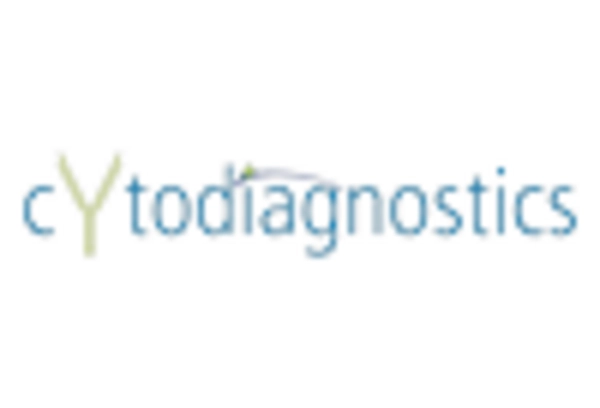The metal nanoparticles market is characterized by a dynamic competitive landscape, driven by advancements in nanotechnology and increasing applications across various sectors, including electronics, healthcare, and environmental remediation. Key players such as BASF SE (DE), Nanoshel LLC (US), and American Elements (US) are strategically positioned to leverage innovation and expand their market presence. BASF SE (DE) focuses on enhancing its product portfolio through research and development, while Nanoshel LLC (US) emphasizes partnerships to broaden its distribution channels. American Elements (US) is actively pursuing regional expansion to cater to the growing demand in North America, collectively shaping a competitive environment that is increasingly innovation-driven.
In terms of business tactics, companies are localizing manufacturing to reduce lead times and optimize supply chains, which is crucial in a market that is moderately fragmented. The competitive structure allows for both established players and emerging firms to coexist, with key players exerting considerable influence over market trends and pricing strategies. This fragmentation encourages innovation, as companies strive to differentiate their offerings in a crowded marketplace.
In September 2025, Nanoshel LLC (US) announced a strategic partnership with a leading semiconductor manufacturer to develop advanced metal nanoparticles for next-generation electronic devices. This collaboration is expected to enhance Nanoshel's technological capabilities and expand its market reach, positioning the company as a key player in the electronics sector. The strategic importance of this partnership lies in its potential to drive innovation and meet the increasing demand for high-performance materials in electronics.
In October 2025, American Elements (US) launched a new line of environmentally friendly metal nanoparticles aimed at the renewable energy sector. This initiative reflects the company's commitment to sustainability and aligns with the growing trend towards eco-friendly materials. By focusing on sustainable product development, American Elements is likely to attract environmentally conscious customers and enhance its competitive edge in the market.
In November 2025, BASF SE (DE) unveiled a new research facility dedicated to the development of metal nanoparticles for biomedical applications. This investment underscores BASF's commitment to innovation and positions the company to capitalize on the burgeoning demand for nanotechnology in healthcare. The establishment of this facility is strategically significant, as it may lead to breakthroughs in drug delivery systems and diagnostic tools, further solidifying BASF's leadership in the market.
As of November 2025, current trends in the metal nanoparticles market include a strong emphasis on digitalization, sustainability, and the integration of artificial intelligence in product development. Strategic alliances are increasingly shaping the competitive landscape, enabling companies to pool resources and expertise. Looking ahead, competitive differentiation is expected to evolve from traditional price-based competition to a focus on innovation, technological advancements, and supply chain reliability. This shift may redefine market dynamics, compelling companies to invest in R&D and sustainable practices to maintain a competitive edge.

















Leave a Comment